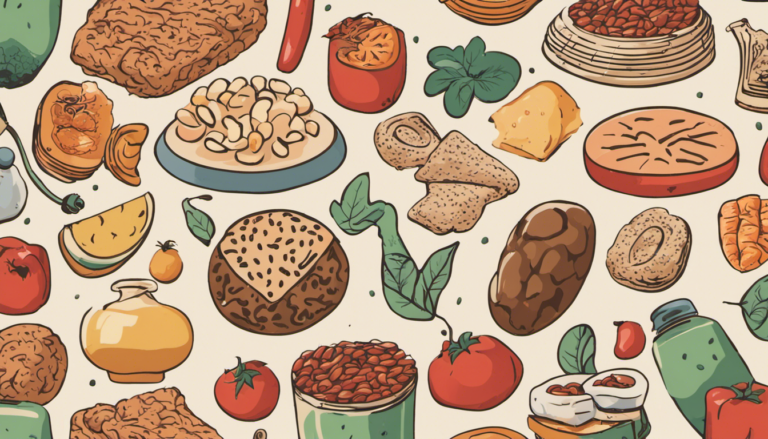Paleo: The Caveman’s Diet
I. Introduction
The Paleo diet, also known as the caveman diet, is a dietary plan based on the types of foods presumed to have been eaten by early humans. It consists mainly of meat, fish, vegetables, and fruit, and excludes dairy, grain products and processed food. The diet is named after the Paleolithic era, a period lasting around 2.5 million years that ended about 10,000 years ago with the development of agriculture and grain-based diets.
The Paleo diet was first popularized in the mid-1970s by a gastroenterologist named Walter Voegtlin. He proposed that modern humans would be healthier if they followed a diet similar to that of their Paleolithic ancestors. The diet gained more attention in the 2000s due to the work of Loren Cordain, a scientist who specializes in nutrition and exercise physiology. Cordain published a book on the Paleo diet and has since become one of its most prominent advocates.
Despite its ancient origins, the Paleo diet is relatively new in terms of dietary trends. It has gained popularity in recent years due to its focus on natural, unprocessed foods and its potential health benefits. However, it has also been the subject of controversy and criticism, particularly in regards to its sustainability and potential nutritional deficiencies.
II. The Philosophy behind Paleo Diet
The Paleo diet is based on the idea that our bodies are better adapted to the diet of our Paleolithic ancestors than to the modern diet. This is because our genes have not changed much since the Paleolithic era, despite significant changes in our diet. The Paleo diet aims to align our food intake with our biological needs and genetic makeup.
The science behind the Paleo diet is rooted in evolutionary biology and anthropology. Research suggests that our ancestors’ diet consisted mainly of wild plants and animals, while grains, dairy products, and processed foods were not part of their diet. This is believed to have kept them free from diseases like obesity, diabetes, and heart disease, which are common in societies with modern diets.
However, it’s important to note that the Paleo diet is not a historical reenactment of our ancestors’ diet. It’s a modern approach to nutrition that uses our knowledge of how our ancestors ate to inform our food choices today. The goal is not to replicate their diet exactly, but to use it as a guide for eating a balanced, nutrient-dense diet.
III. The Basics of Paleo Diet
The Paleo diet emphasizes whole, unprocessed foods. This includes lean meats, fish, fruits, vegetables, nuts, and seeds — foods that in the past could be obtained by hunting and gathering. A Paleo diet limits foods that became common when farming emerged about 10,000 years ago. These foods include dairy products, legumes and grains.
On the Paleo diet, you should avoid processed foods, sugars, dairy, grains, and legumes. This is because these foods are believed to contribute to inflammation, gut health issues, and other health problems. Instead, you should focus on eating a variety of fresh fruits and vegetables, lean meats, seafood, eggs, nuts, and seeds.
While the Paleo diet may seem restrictive, there are plenty of delicious and nutritious foods you can eat. For example, you can enjoy a breakfast of scrambled eggs with spinach and avocado, a lunch of grilled chicken salad with olive oil dressing, and a dinner of steak with roasted vegetables. Snacks can include fresh fruit, nuts, and seeds.
IV. Benefits of Paleo Diet
There are several potential benefits of following a Paleo diet. One of the most notable is weight loss and improved body composition. By eliminating processed foods and sugars, you’re likely to consume fewer calories and lose weight. Additionally, the emphasis on protein and fiber can help you feel full and satisfied, reducing overeating.
Another potential benefit of the Paleo diet is better gut health. The diet eliminates foods that can be hard on the gut, like grains and legumes, and encourages the consumption of nutrient-dense, whole foods. This can help improve digestion and reduce inflammation in the gut.
The Paleo diet may also help reduce inflammation in the body. Chronic inflammation is linked to many health problems, including heart disease, cancer, and autoimmune diseases. By eliminating foods that can contribute to inflammation, like processed foods and sugars, the Paleo diet may help reduce your risk of these diseases.
V. Criticisms and Controversies of Paleo Diet
Despite its potential benefits, the Paleo diet has been criticized for several reasons. One of the main criticisms is that it can lead to nutrient deficiencies. By eliminating entire food groups like grains and dairy, you may miss out on essential nutrients like calcium and vitamin D. However, these deficiencies can be mitigated by eating a diverse range of foods and taking supplements if necessary.
Another criticism of the Paleo diet is its high meat consumption. While meat is a good source of protein and other nutrients, excessive consumption can have negative health and environmental impacts. It’s important to choose lean meats and incorporate plenty of fruits and vegetables into your diet to balance out your meat consumption.
The Paleo diet can also be expensive and difficult to adhere to. Fresh fruits, vegetables, and lean meats can be more costly than processed foods, and it can be challenging to avoid grains, dairy, and sugars in today’s food environment. However, with careful planning and preparation, it’s possible to follow a Paleo diet on a budget and make it a sustainable lifestyle change.
VI. Paleo Diet vs. Other Diets
The Paleo diet is often compared to other popular diets, like the keto diet, the vegan diet, and the Mediterranean diet. While these diets have some similarities, they also have key differences.
The keto diet, like the Paleo diet, emphasizes whole foods and eliminates grains and sugars. However, the keto diet is much lower in carbs and higher in fat, while the Paleo diet includes more fruits and vegetables and doesn’t restrict carbs as much.
The vegan diet, on the other hand, eliminates all animal products, while the Paleo diet includes meat, fish, and eggs. The Mediterranean diet, like the Paleo diet, emphasizes fruits, vegetables, and lean proteins, but it also includes grains, dairy, and moderate amounts of wine.
Ultimately, the best diet for you depends on your individual needs, preferences, and health goals. It’s important to choose a diet that you can stick to long-term and that provides all the nutrients your body needs.
VII. Practical Tips for Starting a Paleo Diet
If you’re considering starting a Paleo diet, here are some practical tips to help you get started. First, plan your meals and prepare your food in advance. This can help you avoid the temptation of processed foods and make it easier to stick to your diet.
Second, be prepared for cravings. It’s normal to crave foods that you’re used to eating, especially when you first start a new diet. Try to find Paleo-friendly alternatives for your favorite foods, and remember that cravings usually decrease over time.
Finally, stay motivated. Remember why you decided to start a Paleo diet, and keep track of your progress. Celebrate your successes, and don’t get discouraged if you have setbacks. Changing your diet is a big lifestyle change, and it’s okay to take it one step at a time.
VIII. Conclusion
In conclusion, the Paleo diet is a dietary approach that emphasizes whole, unprocessed foods and aims to align our diet with our biological needs. It has potential benefits like weight loss, improved gut health, and reduced inflammation, but it also has potential downsides like nutrient deficiencies and high meat consumption.
Whether the Paleo diet is right for you depends on your individual needs and health goals. It’s important to do your research, talk to your doctor, and consider your lifestyle and preferences before starting any new diet.
Remember, there’s no one-size-fits-all approach to nutrition. The best diet for you is the one that you can stick to long-term and that provides all the nutrients your body needs.
FAQs
What is the Paleo diet?
The Paleo diet is a dietary plan based on the types of foods presumed to have been eaten by early humans. It consists mainly of meat, fish, vegetables, and fruit, and excludes dairy, grain products and processed food.
What are the benefits of the Paleo diet?
Potential benefits of the Paleo diet include weight loss, improved gut health, reduced inflammation, improved sleep patterns, and increased energy levels.
What are the criticisms of the Paleo diet?
Criticisms of the Paleo diet include potential nutrient deficiencies, high meat consumption, the expense of the diet, and difficulty in adherence.
How does the Paleo diet compare to other diets?
The Paleo diet is often compared to other popular diets, like the keto diet, the vegan diet, and the Mediterranean diet. While these diets have some similarities, they also have key differences.
What are some tips for starting a Paleo diet?
Some tips for starting a Paleo diet include planning your meals and preparing your food in advance, being prepared for cravings, and staying motivated.







